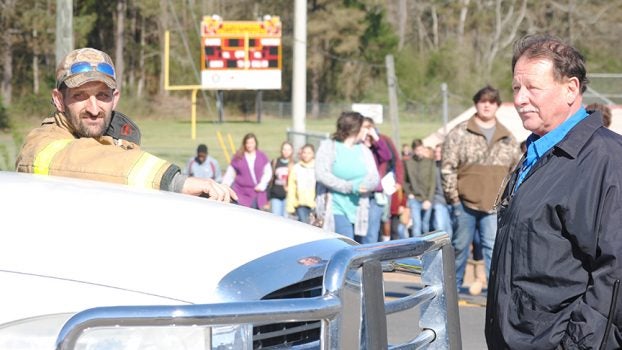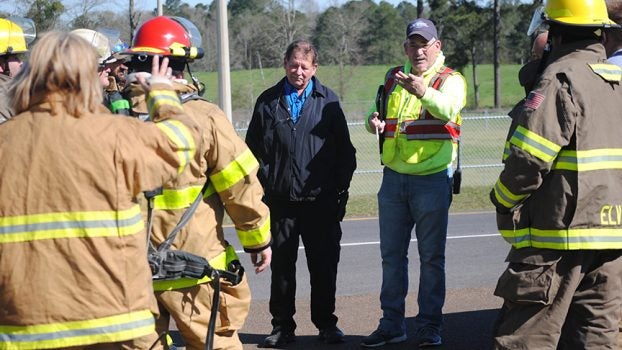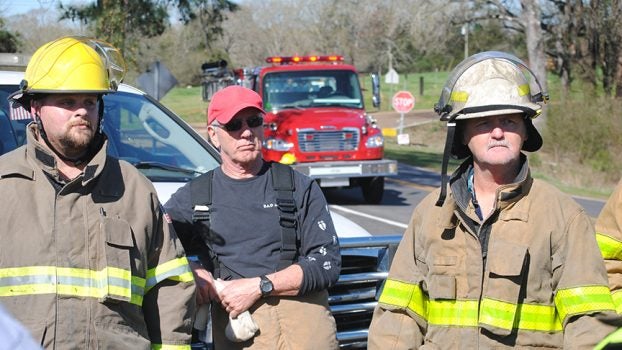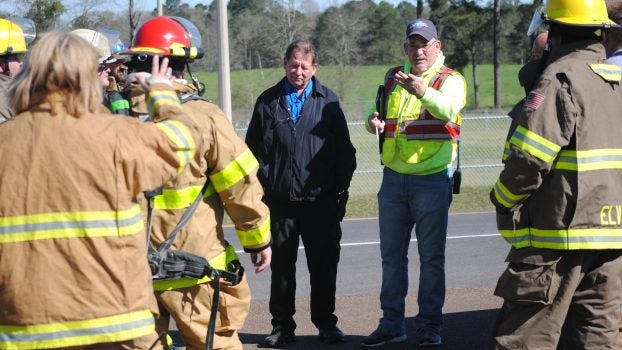Chief: All clear at Enterprise ‘fire’
Published 1:07 pm Friday, March 3, 2017
A search and rescue team of firefighters responding to a burning building on the Enterprise school campus Thursday were tasked with finding a missing teacher and two students as others began battling an imaginary blaze.
It was a mock fire drill, staged to provide valuable training to the three volunteer departments who serve the Enterprise Attendance Center, which includes K-12th grades. Those are Ruth, East Lincoln and Hog Chain.
Trucks began arriving at 9:22 a.m., moments after a Lincoln County Sheriff’s deputy pulled into the driveway of the school. Students had already been led out of the buildings by designated personnel, and took their spots on the football field.
To eliminate confusion, parents were notified of the drill through notes sent home with students the day before, said Glifford Galey, Lincoln County emergency manager and fire coordinator.
The drill served several purposes, he said. It allowed school personnel to test their procedures in case of a fire on campus, and it allowed first responders to practice their emergency procedures as well.
Though they knew the situation wasn’t real, firefighters were fed details and had to respond accordingly.
Steve Reeves of the East Lincoln VFD, clipboard in hand, directed the action. He advised Hog Chain firefighters there were high flames coming from the center of a building further back on campus. Their unit relocated closer to the campus and the Enterprise VFD until covered the rear of the campus by the buses.
“We put it here (in the center building) SR: “We put it here (in this particular building) to make it as hard as possible,” he said.
Firefighters were told a student was missing. A search team set out to find a 5-year-old, looking in the appropriate building.
The search team leader calls incident command, staged near the school entrance, on the radio. “Verify that we’re looking for a 5-year-old,” he said.
“Negative. It’s a fifth grader,” said a voice on the radio.
In the third building searched — the cafeteria — the team found two girls, a fifth- and sixth-grader. They were “suffering” from smoke inhalation, and taken to EMTs from King’s Daughters Medical Center, who had arrived and set up with two ambulances near the incident command center.
“I want EMTs to feel the burn, too,” Reeves said, referring to the training.
While some of the search team transported the missing students to EMTs, others worked the fire in the first building that had been searched. Another call comes over the radio, alerting them a female firefighter is down with a broken right leg and third-degree burns.
Reeves instructed the team in the correct way to carry an injured firefighter out of a building, but to prevent real injuries in the mock drill, the firefighter was escorted to the ambulance instead of carried.
The imaginary blaze was put out and incident command issued an all clear. Students returned to class as firefighters gathered at the incident command post — the hood of Galey’s pickup — to go over the drill.
Reeves gave them the good news. “From the time they called ‘code red’ to the time the buildings were empty was three minutes. That’s excellent,” he said.
Through the exercise, firefighters learned that each truck needs to have a map showing the current layout of the campus. Some of the firefighters attended the school, but new classrooms have been added. Reeves reminded them that in a real fire, not only may they be unfamiliar with the layout, but the visibility would also be poor or non-existent because of the smoke.
Galey and Reeves went through the checklist of what the firefighters encountered and how they handled the problem such as finding the location of fire hydrants, getting fire trucks around school buses, a chemistry lab near the fire, communicating with incident command leader and the possibility that a medical helicopter would need to land on the football field where students had been taken to escape the fire.
Chris Carter, a Ruth firefighter, served as the incident commander. “It went good, but Chris made a couple of mistakes because this was his first time doing IC,” Galey said.
Galey pointed out that Carter was left at IC alone and had no help communicating with the various agencies, which would have included Mississippi Highway Patrol if it had been a real fire. “He was doing a good job taking care of you and this fire. But he wasn’t communicating with law enforcement and the school,” Galey said.
“Keep somebody with you,” he told Carter and the other firefighters who may at any time be put in the IC position. “This is what I need you to do.
“Everybody’s talking to him. Somebody should have been there to help him as IC. You need to have a law enforcement person to talk to law enforcement. You need an EMT person to talk to EMTs. You need a fire person to talk to the firefighters. Nobody can take of everything (by themselves. It takes us all working together, because one person can’t do it.”
Galey also stressed to firefighters that as incident command in an emergency, they’ll be dealing with frantic parents and news media. “Parents are going to go straight to the command center and start screaming and hollering at you. We need law enforcement keeping them back from you,” he said. “Today we let the news media go with y’all. If this was real life, I wouldn’t have let them go. It would’ve made them mad, but they wouldn’t need to be in there.”
During the briefing, Galey told the EMTs that the ambulances were too close to the “fire.”
“That’s a no-no, to move triage that close to the fire,” he said. Galey also noted that some trucks were too close as well. “Don’t move fire trucks too close to the buildings. The Hog Chain truck could’ve caught on fire,” he said.
One firefighter said she’d like to have more mock drills like this one.
Principal Terry Brister worked with Galey to participate in the drill because one of this magnitude had not been done on the campus in several years. This is is first year as principal.
“I hope the other county schools would want to do this,” Reeves aid. “If this was real, we’d have all the county departments and probably the city departments out here.”
“It’s better to be prepared. You hope for the best and plan for the worst.”
Galey said he’d like to see schools have an active shooter drill, probably on a teacher work day when students would not be present. He’d also like to prepare for a tornado destruction drill.









